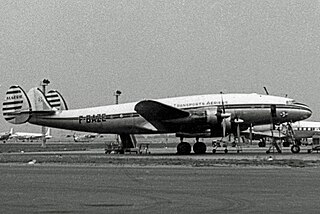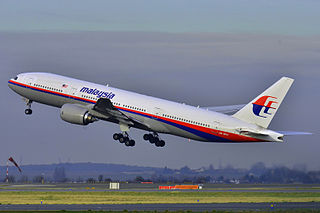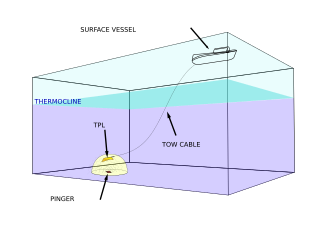

An underwater locator beacon (ULB), underwater locating device (ULD), or underwater acoustic beacon is a device that emits an acoustic pulse intended to guide searchers equipped with a suitable receiver to the location of the beacon underwater.


An underwater locator beacon (ULB), underwater locating device (ULD), or underwater acoustic beacon is a device that emits an acoustic pulse intended to guide searchers equipped with a suitable receiver to the location of the beacon underwater.
An underwater locator beacon is fitted to aviation flight recorders such as the cockpit voice recorder (CVR) and flight data recorder (FDR). ULBs are also sometimes required to be attached directly to an aircraft fuselage. These ULBs are triggered by water immersion; most emit an ultrasonic 10ms pulse once per second at 37.5 kHz ± 1 kHz. [1] [2] [3]
Research by the French Bureau d'Enquêtes et d'Analyses pour la Sécurité de l'Aviation Civile (BEA) has shown that it has had a 90% survival rate spanning 27 air accidents over the sea. [4] The ULBs fitted in Air France Flight 447, which crashed on 1 June 2009, were certified to transmit at 37.5 kHz for a minimum of 30 days at a temperature of 4 °C. After investigating the crash, the BEA recommended that FDR ULBs' transmission period be increased to 90 days and for "airplanes performing public transport flights over maritime areas to be equipped with an additional ULB capable of transmitting on a frequency (for example between 8.5 kHz and 9.5 kHz) and for a duration adapted to the pre-localisation of wreckage" (i.e. with increased range). [5]
On ships built on or after 1 July 2014, underwater locating devices must ensure a regulatory transmission time of at least 90 days. [6]
A beacon is typically supplied with electrical power by a lithium battery, which needs to be replaced after several years. Once the beacon becomes immersed into water, a built-in "water switch" activates it via the water's presence completing an electrical circuit, and the beacon starts emitting its "pings"; the battery power should be sufficient for 30 to 40 days after the activation. The minimum battery voltage is 2.97 volts and the maximum is 3.5 volts. [7]
The National Transportation Safety Board reported a case in 1988, involving an Aerospatiale AS-355F-1 helicopter, when the water switch had accidentally activated during the aircraft's normal operation; as a result, the battery power had been exhausted by the time the accident happened, and the beacon was not emitting the acoustic signal when it needed to do so. [8]
A 37.5 kHz (160.5 dB re 1 μPa) pinger can be detectable from the surface from a distance of 1–2 kilometres (0.62–1.24 mi) in normal conditions and 4–5 kilometres (2.5–3.1 mi) under ideal conditions. [9] [10]

Sonar is a technique that uses sound propagation to navigate, measure distances (ranging), communicate with or detect objects on or under the surface of the water, such as other vessels.

Echo sounding or depth sounding is the use of sonar for ranging, normally to determine the depth of water (bathymetry). It involves transmitting acoustic waves into water and recording the time interval between emission and return of a pulse; the resulting time of flight, along with knowledge of the speed of sound in water, allows determining the distance between sonar and target. This information is then typically used for navigation purposes or in order to obtain depths for charting purposes.

The Bureau of Enquiry and Analysis for Civil Aviation Safety is an agency of the French government, responsible for investigating aviation accidents and incidents and making safety recommendations based on what is learned from those investigations.

Paris–Le Bourget Airport is an airport located within portions of the communes of Le Bourget, Bonneuil-en-France, Dugny and Gonesse, 6 NM north-northeast of Paris, France.

A flight recorder is an electronic recording device placed in an aircraft for the purpose of facilitating the investigation of aviation accidents and incidents. The device may often be referred to colloquially as a "black box", an outdated name which has become a misnomer—they are now required to be painted bright orange, to aid in their recovery after accidents.

Le Bourget is a commune in the northeastern suburbs of Paris, France. It is located 10.6 km from the center of Paris.

A sonobuoy is a small expendable sonar buoy dropped from aircraft or ships for anti-submarine warfare or underwater acoustic research. Sonobuoys are typically around 13 cm (5 in) in diameter and 91 cm (3 ft) long. When floating on the water, sonobuoys have both a radio transmitter above the surface and hydrophone sensors underwater.

Brit Air was a regional airline based at Morlaix Airport in Ploujean, Morlaix, Brittany, France, operating scheduled services as an Air France franchise from Lyon–Saint Exupéry Airport, Paris-Orly Airport and Paris-Charles de Gaulle Airport.

Just before 2:00 pm on 1 April 2009, Bond Offshore Helicopters Flight 85N crashed 11 nautical miles (20 km) north-east of Peterhead, Scotland in the North Sea while returning from a BP oil platform in the Miller oilfield, 240 km (150 mi) north-east of Peterhead. The crash killed all sixteen people aboard. The flight was operated using a Eurocopter AS332L2 Super Puma Mk 2 belonging to Bond Offshore Helicopters. The cause of the crash was main rotor separation following a catastrophic gearbox failure.
The Directorate General for Civil Aviation is the French civil aviation authority. Its headquarters are in the 15th arrondissement of Paris, 50 Henry-Farman. It is subordinate to the Ministry of Ecology, Sustainable Development and Energy.
The French Land Transport Accident Investigation Bureau is an agency of the French government formed in 2004 and charged with the investigation into accidents involving all forms of land transport, including railways, urban guided transportation systems, cable-hauled transport systems, road transport, and canals and other navigable inland waterways. It is headquartered in the Tour Voltaire in La Défense business district in Puteaux.

On 6 January 1993, Lufthansa CityLine Flight 5634 departed Bremen Airport for Paris-Charles de Gaulle Airport at 17:30. Operating the flight was a Dash 8-300, registered D-BEAT with 23 passengers and crew.

On 13 September 2010, Conviasa Flight 2350, an ATR 42 on a domestic passenger service from Porlamar to Ciudad Guayana, Venezuela, crashed shortly before landing, killing 17 of the 51 people on board; 23 others were injured.
Agence Nationale de l'Aviation Civile et de la Météorologie (ANACIM), in English the National Agency of Civil Aviation and Meteorology, is the national civil aviation authority and meteorology agency of Senegal, with its head office on the property of Léopold Sédar Senghor International Airport in Dakar.

Air France Flight 009 was a scheduled international flight that crashed into a mountain while attempting to land at Santa Maria Airport, Azores on a stopover during a scheduled international passenger flight from Paris-Orly Airport to New York City. All 48 people on board were killed.

Malaysia Airlines Flight 370 (MH370/MAS370) was an international passenger flight operated by Malaysia Airlines that disappeared from radar on 8 March 2014 while flying from Kuala Lumpur International Airport in Malaysia to its planned destination, Beijing Capital International Airport in China. The reason for its disappearance has not been determined.

A towed pinger locator is a water-borne device used to locate the sonar "ping" from the underwater locator beacon which is fitted to the Cockpit Voice Recorders and Flight Data Recorders installed in commercial airliners. They can locate pingers at depths of up to 20,000 feet (6,100 m) underwater.

The 1973 Nantes mid-air collision occurred when two airliners travelling to London Heathrow airport hit each other over Nantes, France, on 5 March 1973. They were an Iberia McDonnell Douglas DC-9 flying from Palma de Mallorca to London and a Spantax Convair 990 from Madrid to London. All 68 people on board the DC-9 were killed. The CV-990 was able to make a successful emergency landing at Cognac – Châteaubernard Air Base.

The disappearance of Malaysia Airlines Flight 370, a scheduled international passenger flight from Kuala Lumpur International Airport to Beijing Capital International Airport on 8 March 2014, prompted a large, multinational search in Asia and the southern Indian Ocean that became the most expensive search in aviation history. Analysis of communications between the aircraft and Inmarsat by multiple agencies has concluded that the flight ended in the southern Indian Ocean.

The timeline of Malaysia Airlines Flight 370 lists events associated with the disappearance of Malaysia Airlines Flight 370—a scheduled, commercial flight operated by Malaysia Airlines from Kuala Lumpur International Airport to Beijing Capital International Airport on 8 March 2014 with 227 passengers and 12 crew. Air traffic control lost contact with Flight 370 less than an hour into the flight, after which it was tracked by military radar crossing the Malay Peninsula and was last located over the Andaman Sea. Analysis of automated communications between the aircraft and a satellite communications network has determined that the aircraft flew into the southern Indian Ocean, before communication ended shortly after 08:19 (UTC+8:00). The disappearance initiated a multi-national search effort that became the most expensive search in aviation history.
{{cite web}}: CS1 maint: archived copy as title (link){{cite news}}: CS1 maint: unfit URL (link)